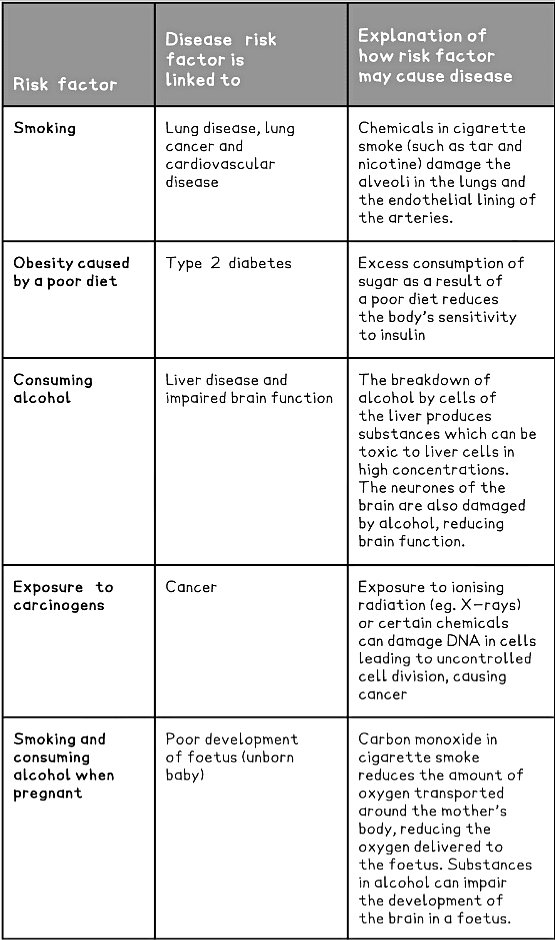Grade 10 Exam > Grade 10 Notes > Biology for Grade 10 > Lifestyle & Non-Communicable Diseases
Lifestyle & Non-Communicable Diseases | Biology for Grade 10 PDF Download
| Table of contents |

|
| Risk Factors |

|
| Causal Mechanisms & Risk Factors |

|
| Sampling, Translating & Interpreting Data |

|
| Applications of Non-Communicable Diseases |

|
Risk Factors
- Risk factors are linked to an increased rate of a disease; but exposure to a risk factor doesn’t guarantee that an individual will suffer a disease (a person who smokes regularly isn’t guaranteed to develop lung cancer but their risk compared to someone who doesn’t smoke is much, much higher)
- Certain risk factors correlate with certain diseases (are related to them); but correlations are not always causations
- Risk factors can be:
- Aspects of a person’s lifestyle; such as the food they eat or whether or not they drink alcohol
- Substances in the person’s body or environment; such as air pollution in a crowded city or asbestos in old buildings
Causal Mechanisms & Risk Factors
- A causal mechanism has been proven for some risk factors, but not in others
Risk factors & causal mechanisms table
- Many diseases are caused by the interaction of a number of factors; the chance of developing cardiovascular disease is higher in individuals who have a poor diet high in cholesterol (fat), don’t exercise regularly and smoke – because all of these behaviours increase the likelihood of damage occurring to the arteries
Sampling, Translating & Interpreting Data
- Sampling allows researchers to infer (deduce/conclude) information about a population without having to investigate every individual which would be time-consuming and essentially impossible to do accurately
- Scientists sample populations to determine risk factors for different diseases and inform public health policy
- For example; sampling individuals with type 2 diabetes and identifying patterns or similarities in their lifestyle and health condition allows scientists to deduce that obesity and a diet high in sugar and fat are risk factors for developing this condition (as these factors are found in most individuals who develop type 2 diabetes)
- Scientists present their findings in graphical and numerical forms top identify if there are relationships between risk factors and certain disease
- Scatter diagrams are used to identify correlations between two variables to determine if a factor (such as obesity) does increase the risk of developing a disease (such as type 2 diabetes)
Exam Tip: You should be able to translate information between graphical and numerical forms and extract and interpret information from charts, graphs and tables to determine risk factors.
Applications of Non-Communicable Diseases
- Lifestyle factors such as diet, alcohol consumption and choosing to smoke have a big impact on the incidence of non-communicable diseases at all levels in society (from the individual to national and globally)
- Poor lifestyle factors such as those mentioned above increase the likelihood of individuals within a population suffering from non-communicable disease
- Remember a non-communicable disease is not caused by a pathogen and tends to have more longer-lasting effects on the health of an individual (usually they get progressively worse over time)
Smoking as an example
- An individual who smokes cigarettes is far more likely to suffer lung cancer than an individual who doesn’t
- Treatment for cancer includes surgery, radiotherapy and chemotherapy – all of these require hospitalisation and access to the right medication
- Hospitalisation utilises healthcare capacity and medicinal drugs – costing time and money at both a local and national level (and a personal level if healthcare is self-funded)
- The individual with lung cancer may not be able to work whilst receiving treatment, this reduces their income and loss of work can have a profound effect on mental health
- Nationally; the inability of individuals to work can affect a countries economy
- A causal mechanism has been proven for some risk factors, but not in others
Exam Tip: You should be able to discuss the human and financial cost of non-communicable diseases (such as cancer or CHD) at an individual, a local community, a national and a global level.
The document Lifestyle & Non-Communicable Diseases | Biology for Grade 10 is a part of the Grade 10 Course Biology for Grade 10.
All you need of Grade 10 at this link: Grade 10
|
102 videos|93 docs|13 tests
|
Related Searches



















